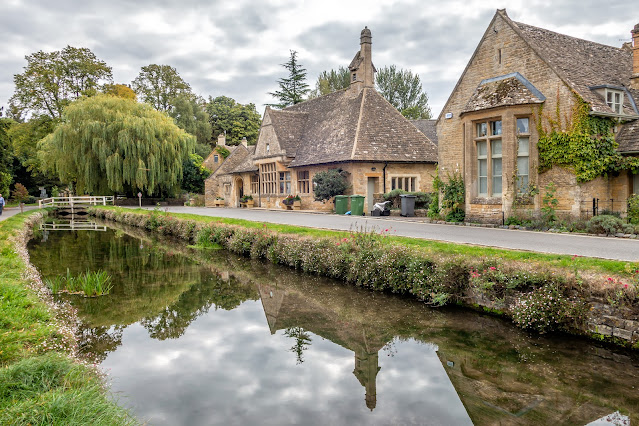Upper and Lower Slaughter, then on to Wych Rissington
The three villages to visit today were in close proximity and just required judicial parking, and some walking - no problem, we thought! We aimed for Lower Slaughter, which was not a huge distance from Stow on the Wold, as our starting point.
The village is built on both banks of the River Eye, a slow-moving stream crossed by two footbridges, which also flows through Upper Slaughter. There is a ford where the river widens in the village and several small stone footbridges join the two sides of the community. While the mill is built of red brick most of the 16th and 17th century homes in the village use Cotswold limestone and are adorned with mullioned windows and often with other embellishments such as projecting gables.
At the west end of the village there is a 19th-century water mill with an undershot waterwheel and a chimney for additional steam power.
From here we headed across a field to Upper Slaughter, passing this gate with a plaque on it which conjured up some memories.
Memories of past tragedy.
We made a bee line for St peter`s Church where there has been a church since at least the 12th century, and possible as early as the 11th century. The first rector is recorded in 1251 and appears to have been an Italian.
St Peter does seem to have had some interesting rectors over the centuries; In the 14th century, three rectors in a row had permission to be absent from the benefice (i.e. they were absentee rectors).
Later that century the rector was a notable 'Chop church', that is, he was known to exchange benefices with other rectors. 'Chopping' was the practice of buying and selling benefices to the highest bidder, or in some cases, trading benefices between rectors for personal gain. No wonder the church was so rich in that era!Under the tower arch is a deeply cut 15th-century font. It is so large that it may have originally been a 12th-century tub font, cut down in the late medieval period to its current shape. The carving is very worn, which is not surprising when you consider that from 1877 it stood in the churchyard for 20 years before it was brought back inside the church.
So, back to Lower slaughter and a short drive to Bourton-on-the-Water, and from there a walk to Wych Rissington.
The start of the pathway leads to open fields. About one and half miles I believe.
So peaceful. We saw just one car as we walked the length of the village to the church.
The Victorian drinking fountain on the village green. Also used as a place for memorial flowers to be placed today.
One claim to fame for this church was that Gustav Holst, the celebrated composer, fresh from school in Cheltenham, was an organist here in 1892/3 and the organ he used is still in use. How about that for fame! Although there were doubtless many interesting things about this church, this fact for me was one of the best.






















Comments